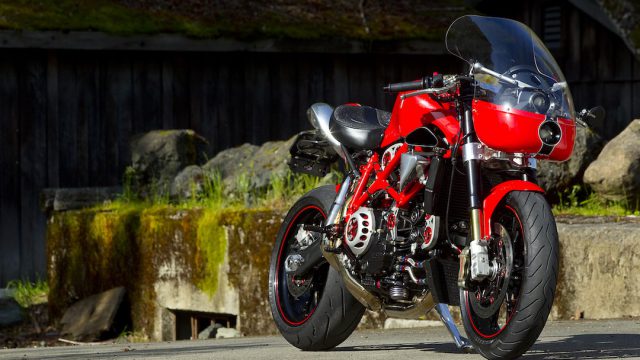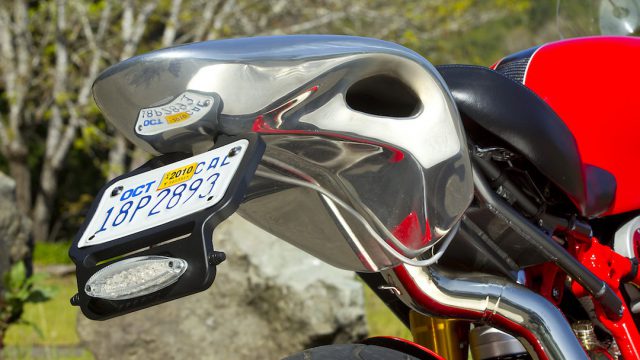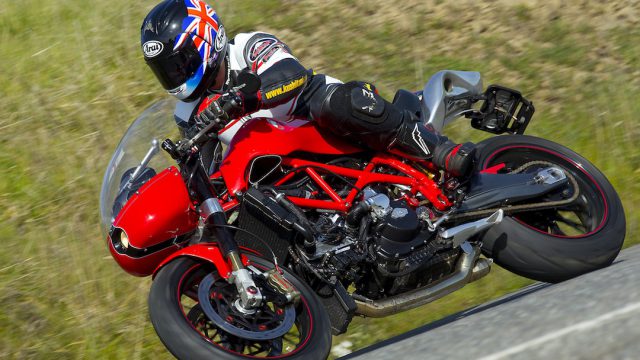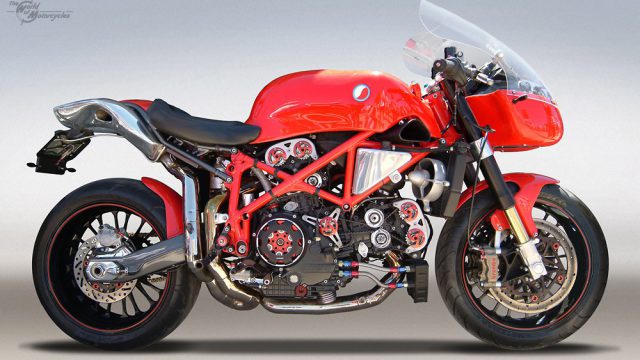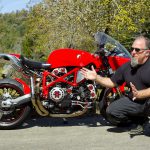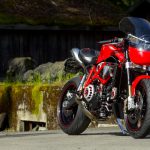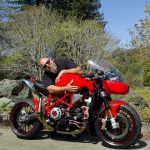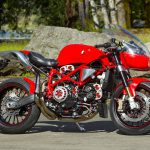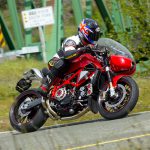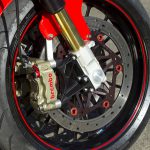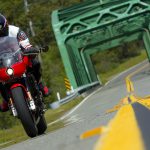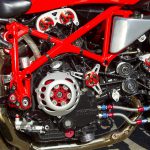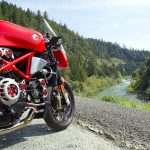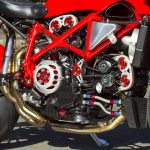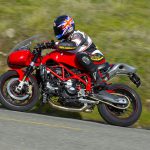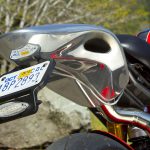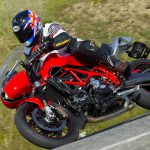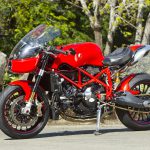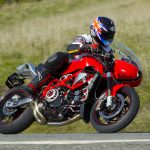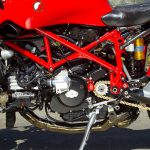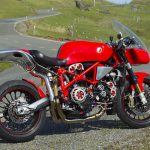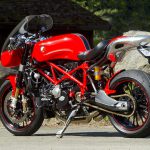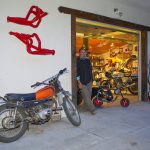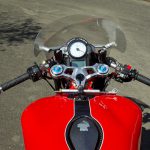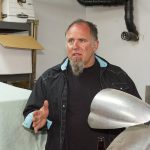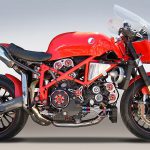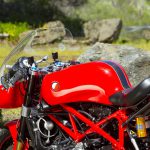Exclusive test ride in the lost hills of Northern California
Created by award-winning custom bike builder Robert Steffano in his ACME Rocket Bike workshop 3,000ft up in the redwood forests, amid the marijuana fields, 25 miles/40km from any tarmac road, accessed via his rock star partner’s drum kit hauler van.
Bob Steffano is an affable Northern Californian with a talent for creating two-wheeled works of art – and then riding the wheels off them. The Steffano Ducati Café9 is a mechanically stock 999 desmo V-twin that’s been completely reworked by Bob’s ACME Rocket Bike award-winning design house into an eye-candy customised Café Superbike racer-with-lights, that’s sufficiently striking to have featured on magazine covers, and garnered acres of print globally – but which can be ridden and street raced just like a real world motorcycle.
Garberville, California (pop. 913) sits in the thick redwood forests comprising Humboldt County, 200 miles north of San Francisco just inland from the Pacific Ocean’s desolate so-called Lost Coast. It’s a tiny waypoint on US-101 surrounded by the tall King Mountains range littered with impenetrable trails. BBC-TV has termed Garberville “the marijuana heartland of the USA”, and it even boasts an educational establishment named Cannabis College (honestly!), which gives you an idea of the local culture. But until quite recently it was also the home of the ACME Rocket Ship Motorcycles emporium that’s produced an award-winning array of café racer customs able to be ridden as well as admired, using as eclectic a base as a Velocette single, through to a Ducati 916 or Yamaha R1.
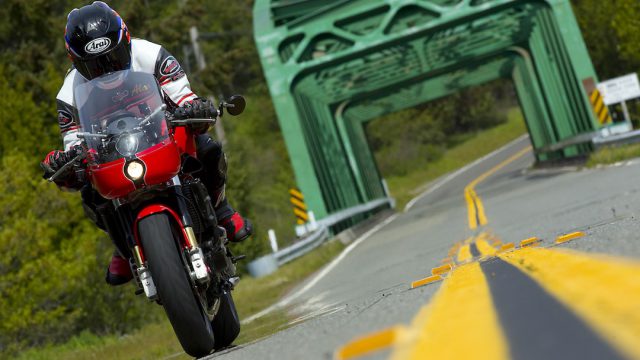
But then its owner Bob Steffano, who’s also the proprietor of a successful house-building company, decided to move the ACME workshop into the grounds of the new home he’d built 3,000ft up in the hills for himself and his rock star partner Tina Gordon – she’s the drummer with top female tribute band AC/DShe. But the nearest paved highway is 25 miles/40km away, over rugged dirt roads and a handful of mountains – conditions which presumably explained the two flat tyres on Steffano’s Subaru WRX sitting in the yard of his home when I came visiting! No matter – lots of room to park up the well-used Dodge van which formerly served as Tina’s drum kit transporter, and now hauls the two-wheeled trophy-winners that Steffano creates there back and forth to the highway each time he wants to ride one, perhaps down 101 to the apartment in San Francisco’s Mission District where Bob and Tina split their time.
Steffano majored in Mechanical Engineering from Arizona State University, and has been a motorcycle junkie ever since his early teens – “My first bike was a four-speed 50cc Benelli, and I remember personalising it by painting it out of a rattle can!” He used the University labs to create his first full Custom bike, as a college design project. “I built a full-floater monoshock suspension system onto an old Slash 6 BMW Boxer, added Morris mags, a K100 front end, and a hot-rod twin spark motor with lightweight rockers, and other crazy stuff,” recalls Bob. “It was pretty cool, and quite unique – and I still have it here as a source of inspiration.” Fresh out of college, Steffano applied unsuccessfully to work for Harley, but H-D’s loss was the aerospace industry’s gain, until after 15 years of engineering space-age materials, he decided to move back to Northern California and got a successful construction business going. Steffano Motors came later, in 2005 – but it was originally just a hobby in between construction jobs, until Bob decided to focus just on motorcycles, and took a break from his contracting business to start building bikes.
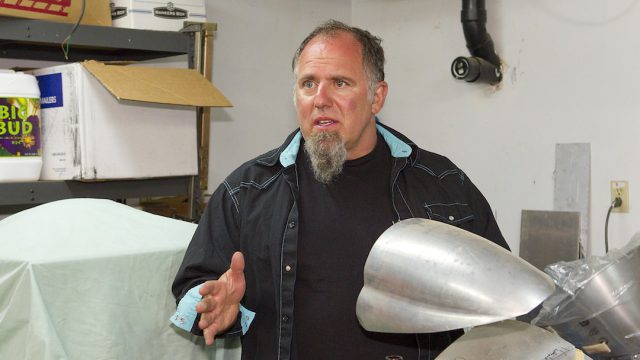
As an avid sportbike rider, Steffano’s priorities were to build designer bikes that could actually be ridden, starting with a custom Ducati 916-based streetfighter with Triumph Speed Triple headlights around the turn of the Millennium. This got sold to a collector up in Oregon, and sired a series of ACME Rocket Bike Custom projects sold through Steffano Motors. So are you ACME customer Wile.E Coyote, or his Road Runner nemesis, Bob? “I think I'm the Road Runner, though I do sometimes feel after a long ride that I got slammed against canyon walls, and blown to smithereens! But ACME Rocket Bike is really about collaboration in design, because I have some really talented people to work with, and it’s like an orchestra – any single instrument sounds cool, but when you get them all playing together, you can really do great stuff.” To good effect, with Steffano’s creations winning the USA’s premier Custom motorcycle Best In Show awards at the Grand National Roadster Show, and the ultra-prestigious Pebble Beach Concours held annually at Quail Lodge, Monterey.
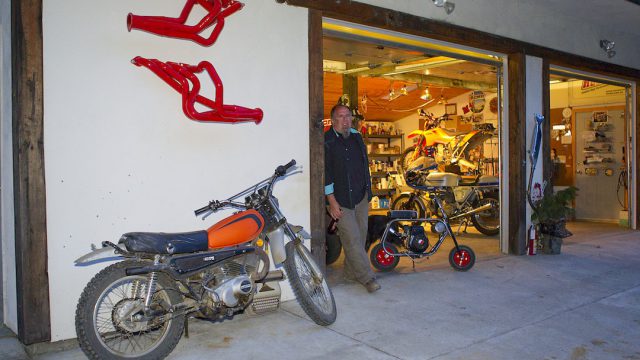
So how come the Ducati 999-based Café9? “Pierre Terblanche is such a great designer, and the 999 is a cool, very daring design,” says Bob. “A lot of people didn’t like that bike, but a whole lot of others did – including me. I just felt that something had to happen to the breadbox exhaust!”
Working with NorCal neighbour and metalwork maestro Evan Wilcox in nearby Ukiah, Bay Area creator of aviation-grade carbon fibre components James Porreco of Finish Line Advanced Composites, local CNC machinist Bobby Hill, and the Kosman Specialities custom house just north of San Francisco, who collectively sourced the parts needed to create the Café9 according to his concept drawings and/or CAD images, Steffano has extensively revamped the desmo Ducati sportbike. He’s junked the bodywork, and stripped the trellis frame down to the bare metal to remove all unwanted tabs and brackets, before smoothing out the result and covering it with a high-temperature epoxy coating in a glossy deep Concourse Red tint. The V-twin engine has received a similar semi-gloss black finish, but remains stock inside, though customers can specify uprated tuning courtesy of the Fast by Ferracci or Ducati Performance parts catalogues.
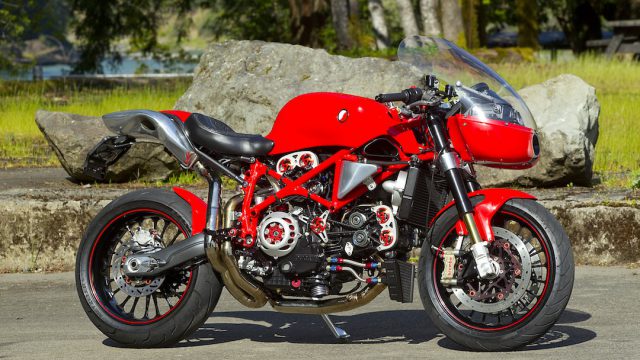
Now comes all the trick stuff, starting with the distinctive-looking fuel tank, which is actually the stock 15.5-litre 999 item covered with a shapely carbon shroud taken from Wilcox’s original hand-beaten aluminium prototype, with side-entry carbon ducts for the stock airbox – simply unbolt the filler cap assembly, and the shroud can be removed. Next, there’s a specially-made aluminium subframe, which not only mounts the extremely comfortable new carbon fibre seat covered in tactile (and, naturally, waterproof!) stingray hide, but also houses the Marelli ECU and the battery, which on the stock 999 are mounted on the left side of the bike, ready to be revealed in all their massive functionality when the bodywork’s removed. ”The essence of a V-twin motorcycle is seeing the motor out in the open,” says Bob, “so all that stuff had to get moved. For a Custom bike, the 999 is a very technical motorcycle, and getting everything packaged was a challenge.”
The stock wet-cell battery has been replaced by a lightweight Speedcell lithium-ion item located under the seat. “We have the ECU mounted in the open air down there, too,” says Steffano. “To me, it’s mechanically beautiful, with a lovely casing. The starter and solenoid are now positioned between the cylinders on the inside, where there was quite a bit of room to work with. I’m not into hiding the mechanical aspects of a bike, so the wiring loom to me is really interesting to look at. But I want to make it beautiful, so I wrap it in a flexible protective covering, and package the thing so it’s almost kind of like a nervous system! If you see them separated out like that, they’re cool to look at. That’s how a bike should be – here’s the electrical system we need, so let’s make it a thing of beauty.”
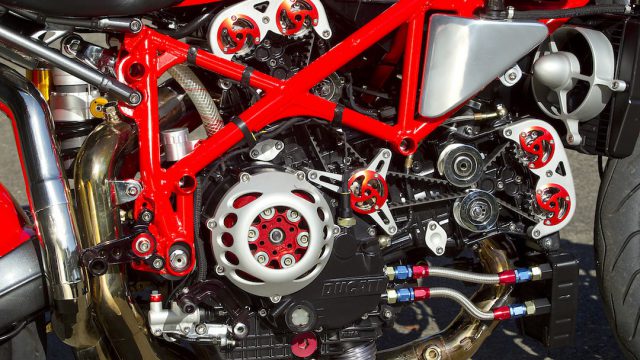
Although the stock Ducati 999 represented a big step forward in more spacious rider packaging and comfort over the 916, Bob Steffano has added to that on the Café9 by raising the beautifully made CycleCat clipon handlebars 3in/75mm, and lowering the adjustable CRG footrests an inch/25mm. CRG made the ‘bar-end mirror on the left clipon with a concave lens that gives good rearwards vision, and folds in for splitting lanes. Speedymoto delivered the cambelt cover logo buttons, the polished aluminium water pump covers, and the clutch pressure plates and robust protective cover milled from T6 alloy, all complimented by Aeroquip stainless steel oil lines and fittings, and Spiegler hydraulic clutch/brake hoses. The ACME aluminium radial-valve master cylinders and one-piece hydraulic reservoirs were machined from solid by Bobby Hill, who also made the aluminium licence plate holder and cooling fan shrouds – these a Kosman design that replaces the original low-rent plastic components. The stock Ducati twin-stack headlamps that aroused so much controversy when the 999 was unveiled have been retained, but Steffano has made lemonade out of the lemon by leaving the housing module in plain view as a styling feature. “It’s a beautiful piece of mechanical art,” he says. “Why hide it?” In pursuit of this, the frame-mounted carbon fibre bikini fairing has been styled so that only the single lower dipped-beam headlamp-cum-running light sits within paintwork, with the upper main-beam light wrapped by the low perspex screen. Very distinctive.
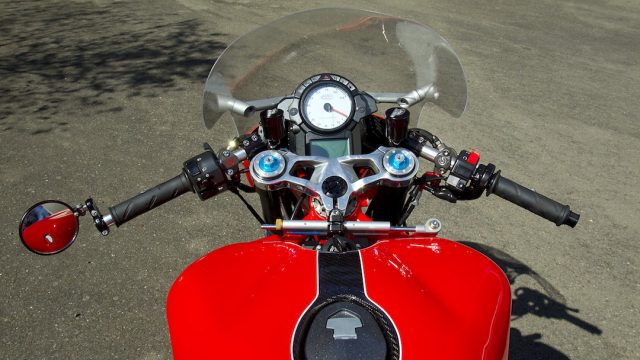
Öhlins suspension front and rear replaces the 999’s stock Showa kit, with the fork tubes anodized black instead of the Swedish suspension sultans’ trademark yellow, coupled with an adjustable steering damper form the same source. Ultra-lightweight 20-spoke forged aluminium PVM wheels shod with Metzeler Sportec MC6 rubber – the rear a fat 190/50-17 on a 6.25in rim – help contribute to a significant weight reduction for the whole bike, with Steffano citing a claimed 170kg/375lb dry for the Café9, a useful saving on the stock 999’s quoted 186kg/410lb weight (which has actually been shown to be a good bit more, once hydraulic fluid etc. has been added). Stopping those kilos are 320mm CNC-cut BrakeTech AXIS cast iron front discs, coated to prevent rust, which replace the stock stainless steel Brembos, but the Italian company’s radially-mounted four-piston two-piece (so, not Monoblock) HP calipers have been retained.
But Steffano’s most striking single design feature on the Café9 is the ultra-distinctive, exquisitely shaped, curvaceously polished, aluminium exhaust canister with distinctive side exits, termed the NER/Native Exhaust Resonator, beautifully fabricated by Evan Wilcox and matched to specially-made Leo Vince titanium headers supplied without mounting tabs. This uses the Helmholtz resonator principle of pressure dynamics, which basically consists of sound waves bouncing off each other to deaden the sound – see http://www.phys.unsw.edu.au/jw/Helmholtz.html. “I'm into a more sensual experience around motorcycles,” says Steffano, “and I definitely appreciate natural forms that are pleasing to the mind as well as the eye, because they’re instinctive. It’s instinctive to look over ocean waves rolling onto a beach – you can stand there for hours just looking at them, or gazing at a rolling vista of mountains, with one range in front of another in front of another. It’s just inspiring. I wanted to bring this three-dimensional depth into the Café9 design, so that it draws you in instinctively, layer after layer. You don’t know why you want to look at it, but you do. I’ve had little old ladies who’ve never looked at a motorcycle before, but who stop to see the Café9 and go, “Wow, that’s really neat, my grandson is into motorcycles,” and so on. If it’s having an impact like that on someone who’s never looked at bikes, then they’re seeing something there that’s more about the design, less about the riding experience. But that has to be right, too!”
[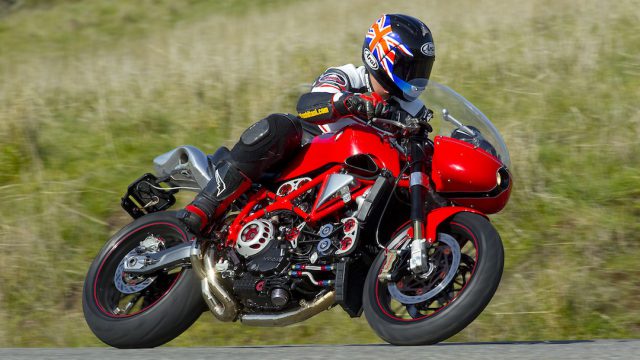
My day’s ride aboard the Café9 told me that indeed it was, and lot of that comes from the extremely comfortable riding position Steffano has tailored, by building on Terblanche’s already rational real-world riding stance on the 999, but taking some extra weight off your shoulders and wrists via the higher ‘bars, without in any way sacrificing handling performance. In fact, manoeuvrability in city streets and tight mountain hairpins is actually improved thanks to the wider spread of the taller clipons, without the risk of trapping your thumbs in extracting the Café9 from a tight parking spot. Though still mounted relatively high to be sure to deliver good ground clearance with the 190-section rear tyre, the lower-set adjustable footrests were dialled in just right for me, allowing my knees to tuck in tight to that shapely tank shroud, in crouching down behind the large perspex screen which delivers mega protection at high speed, as well as a sense of spaciousness. “You know how they do feng shui in houses – well, I’m trying to do that in motorcycles, by making them good places to be in,” says Bob Steffano. “I want to draw people into my bikes.” Ah, so…
So this is an eye candy custom sportbike that’s actually comfortable to ride – how unexpected is that? The only slight disappointment was the resonator exhaust that’s seemingly still work in progress – the Café9’s engine note was actually quieter than a stock 999, and not particularly inspiring by normal desmo V-twin standards, plus the motor would stall occasionally at low speeds, apparently because the ECU hadn’t been reprogrammed for the new port openings Steffano was experimenting with. But the Helmholtz principle certainly works, and the resonator itself is a lovely piece of metallurgy.

“This motorcycle is the result of a collaborative exercise,” says Bob Steffano in his best ACME mission statement mode. “My belief is that within every machinist, painter, mechanic, welder or fabricator, lies an artist. A true craftsman who has spent thousands of hours and many years working in their chosen medium, doing jobs for others, making it their trade. My concept was to combine all of this latent design sense together to see what would happen, with me as design director providing the inspiration that’d culminate in the kind of beautiful Custom bikes that I believed were possible. But our customers must play a role in this, too, by showing off the fruits of our labours to others. If you don’t like attention, then do not buy a Café9!”
* * * * *
Photo credit: Kevin Wing
